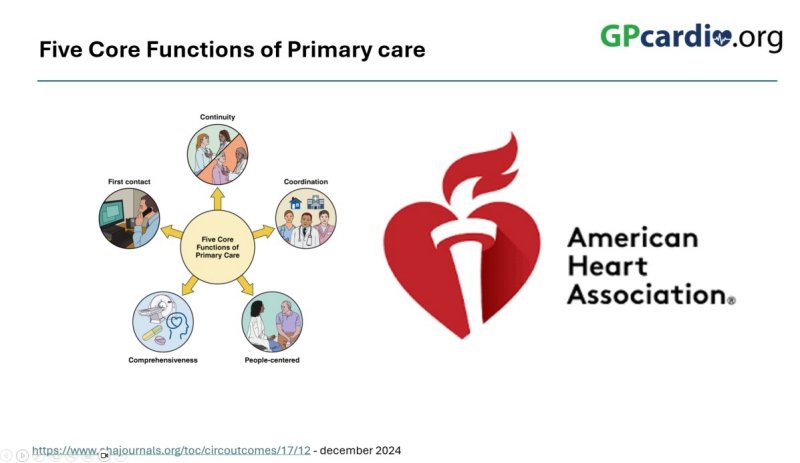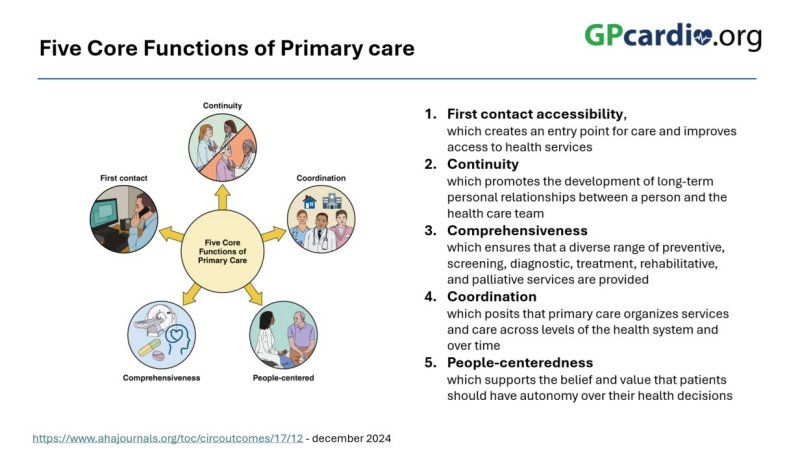
The Vital Role of Primary Care in Advancing Cardiovascular Health
The Role of Primary Care in Achieving Life’s Essential 8: A Scientific Statement From the American Heart Association
Literature - - Circulation: Cardiovascular Quality and OutcomesVolume 17, Issue 12, December 2024; Page e000134The American Heart Association (AHA) recently issued Life’s Esseential 8, stating that Primary care plays a crucial role in delivering whole-person, integrated, and equitable health care that meets most health needs. It is uniquely positioned to identify and address behaviors that conflict with Life's Essential 8 (LE8) and to support populations facing cardiovascular health disparities. However, to maximize its impact on LE8 goals, primary care requires strong backing from the health care community, public health systems, and policymakers. Collaborative partnerships between primary care and other clinicians are essential for implementing guidelines and improving LE8 adoption across all communities.
To reduce morbidity and mortality rates of cardiovascular disease, an urgent need exists to improve cardiovascular health among US adults. In 2022, the American Heart Association issued Life’s Essential 8, which identifies and defines 8 health behaviors and factors that, when optimized through a combination of primary prevention, risk factor management, and effective treatments, can promote ideal cardiovascular health. Because of its central role in patient care across the life span, primary care is in a strategic position to promote Life’s Essential 8 and improve cardiovascular health in the United States. High-quality primary care is person-centered, team-based, community-aligned, and designed to provide affordable optimized health care. The purpose of this scientific statement from the American Heart Association is to provide evidence-based guidance on how primary care, as a field and practice, can support patients in implementing Life’s Essential 8. The scientific statement aims to describe the role and functions of primary care, provide evidence for how primary care can be leveraged to promote Life’s Essential 8, examine the role of primary care in providing access to care and mitigating disparities in cardiovascular health, review challenges in primary care, and propose solutions to address challenges in achieving Life’s Essential 8.
Although the incidence, morbidity, and mortality rates of cardiovascular disease (CVD) have declined in the United States, CVD remains the leading cause of death, and progress remains slow. There are marked disparities in CVD by socioeconomic status, race and ethnicity, sex, and region. One way to improve CVD mortality rates would be to improve overall cardiovascular health (CVH), which can be achieved through improving a combination of health behaviors and health factors. When optimal, CVH is associated with greater CVD-free survival, longevity, and quality of life7.
To guide this approach, in 2022, the American Heart Association (AHA) issued an updated presidential advisory on defining CVH as achieving Life’s Essential 8 (LE8). Building on Life’s Simple 7, LE8 was developed to be understandable and actionable to nonclinicians as well as clinicians and easily quantifiable for assessing population health. Every LE8 measure is modifiable with behavioral change or medication management.
LE8 defines 4 health behaviors (diet, physical activity, nicotine exposure, and sleep) and 4 health factors (body mass index, blood lipid level, blood glucose level, and blood pressure [BP]) as critical to achieving CVH. However, considerable gaps persist in identification, treatment, and control of these 8 factors. Only 1 in 5 people in the United States has optimal CVH, and there are marked disparities in LE8 by socioeconomic status, race, and ethnicity. In response to this, LE8 emphasizes the role of socioeconomic and structural determinants of health, as well as psychological health, well-being, and the brain–mind–heart–body connection. Together, these can positively or negatively affect CVH.8
Because of its central role in patient care and health care delivery, primary care is ideally positioned to help people achieve optimal CVH through LE8. High-quality primary care is the provision of whole-person, integrated, accessible, and equitable health care that addresses health and wellness needs across settings with sustained relationships. Effective primary care is person-centered, team-based, community-aligned, and designed to provide affordable health care. Such care, if promoted and valued by the medical community, public health system, and policymakers, has the potential to improve the identification and treatment of CVH behaviors and risk factors. Recent data suggest that primary care is the dominant source of care for LE8, over subspecialty care.
An opportunity remains to provide evidence-based guidance on how primary care, as a field and practice, can help individuals achieve LE8. A previous scientific statement focused on the role of promoting brain health in primary care, but little has been reported on how primary care can address LE8 and CVH overall. We describe the role and functions of primary care, provide evidence for how primary care can be leveraged to promote LE8, examine the role of primary care in providing access to care and mitigating disparities in CVH, review existing challenges in primary care, and propose solutions to address challenges in achieving LE8. This scientific statement is relevant for patients, clinicians, researchers, community-based organizations, health systems, and policy experts.


Share this page with your colleagues and friends: